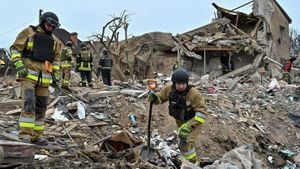Tehran has recently turned the spotlight on Mojtaba Khamenei, the second son of Iran’s Supreme Leader, Ali Khamenei. Reports have surfaced indicating Mojtaba has been selected to succeed his father, who, at 85, is reportedly battling health issues. This decision is shrouded in secrecy, following a closed-door meeting on September 26, 2024, where members of the Assembly of Experts, tasked with overseeing the Supreme Leader's role, were allegedly pressured to vote unanimously for Mojtaba's ascension.
The Assembly of Experts comprises 88 clerics responsible for appointing and supervising the Supreme Leader. Their decision-making is typically extensive, but this time around, it seems to have unfolded under intense scrutiny and pressure from the sitting leader himself and his closest associates. Insiders have suggested the members were made fully aware of the grave consequences they'd face should any details of the meeting leak.
To add to the complexity, Mojtaba Khamenei's emergence as the potential successor was catalyzed by the unexpected death of Ebrahim Raisi, the former president of Iran, which has created more of a leadership vacuum. Although Raisi was considered one of the front-runners for leadership after Ali Khamenei, Mojtaba's name quickly gained prominence as the most viable alternative amid growing internal pressures and discussions about succession.
Historically, Mojtaba has kept a relatively low profile. Born in 1969, he has spent years building influence behind the scenes, particularly within the religious and political spheres of Iran. His educational background began at the religious seminary of Qom, where he is known to have developed significant theological expertise under esteemed clerics. Despite being considered less charismatic than other contenders, his close association with the powerful circles of Iran's clerical elite has bolstered his standing.
Intensifying the debate over Mojtaba’s succession is his contentious past, including his alleged involvement during the events of the 2009 Iranian elections, which led to widespread protests. Analysts claim he played a significant role during those protests, asserting his power by advising the authorities on how to manage dissent. Despite the unrest, he managed to navigate these turbulent waters, which has only positioned him closer to the upper echelons of Iran’s power.
Half of the power dynamics at play involve key institutions such as the Islamic Revolutionary Guard Corps (IRGC), which have historically influenced the political scene. A potential shift from Ali Khamenei to his son, Mojtaba, raises questions about continuity and change within Iran's governance structures. While Iranian politics has long been characterized by factions and powerful interest groups, Mojtaba's success would likely depend on garnering support from these influential entities.
The backdrop against which this leadership transition is occurring is filled with instability—both domestically and internationally. Iran faces increasing scrutiny from the West, especially concerning its nuclear ambitions and support for regional proxies. Herein lies the challenge for Mojtaba: how to unify competing interests and maintain Iran's traditional stance on contentious issues like its rivalry with the United States and Israel amid growing domestic discontent and economic struggles.
The constitutional framework for succession offers some assurance of oversight; the Assembly of Experts is supposed to supervise the leadership. The fact remains, though, the Assembly remains largely symbolic, and as such, dissenting voices within it may not suffice to counteract Mojtaba’s rising influence. The greater fear among many analysts is the potential for increased authoritarianism should he ascend, particularly if he perceives challenges to his rule.
Mojtaba Khamenei’s ascent will undoubtedly be observed not only for its immediate impact but also for how it might reshape Iran’s sociopolitical narrative. A successful handoff of leadership from father to son is not just about family legacy; it also signals to factions within Iran and beyond whether dynastic politics can harmoniously coexist with the country’s Islamic ethos.
Iranian public opinion remains divided. Some view Khamenei’s potential abdication as opening a new chapter, ripe with opportunity for reform, particularly among younger generations seeking improved conditions and greater freedoms, both social and economic. Others express skepticism, fearing the entrenching of authoritarian practices under another Khamenei. The bulk of Mojtaba’s support will likely rely on whether he chooses to engage with these divisions constructively or reinforce existing power structures.
Rumors surrounding Ali Khamenei’s health have suggested he may have taken steps to prepare for his succession. Over recent months, there have been numerous reports about his condition, some of which erroneously claimed he had fallen seriously ill. These rumors, though widely circulated and concerning, remain unconfirmed by official Iranian sources, emphasizing the delicate balance of secrecy and public perception surrounding the current regime.
Fundamentally, the decision to name Mojtaba Khamenei as successor is both about immediate power and future vision for Iran. It highlights the intersection of familial loyalty and the political maneuvering characteristic of Iranian governance. Whether Mojtaba can navigate these waters successfully will largely depend on his ability to address internal dissent and engage with external pressures differently than his father did.
These developments, tightly woven with the fabric of Iran’s complex political history, are sure to reverberate throughout the region and influence international relations. The story of Mojtaba Khamenei has only just begun to unfurl, with Iran’s future resting on the balances of power within and outside its borders.



